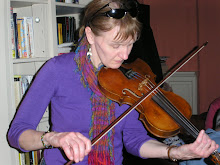


Day 11 Fri April 20
The ferry took us to the Outer Hebridean island of Lewis today. At the Lewis Loom Centre in Stornaway, Ronald McKenzie gave us an overview of the tweed industry. Harris tweed is fabric made from the wool of Scottish sheep, spun in the Outer Hebrides, woven by hand, and finished in the Outer Hebrides. When the potato famine hit Scotland 1845-47, Lady Dunmore took the tweed the islanders were weaving, traveled the world, marked up the price 20x and came back and gave the weaver all the profit. Harris tweed became famous worldwide and the demand kept growing.
Originally the tweed was naturally dyed. Crotal, a lichen, gave light to dark rusty color. Spinning mills came in 1907 and all the yarn was then aniline dyed. In 1926, the Hattersley Loom greated increased the productivity of the weavers. The looms had hands free flying shuttle mechanisms and were powered by stepping alternately on two pedals. In the 1960’s
Today there are 150-200 weavers on the island that supply the industry weaving on Rapier looms that are driven with a pedals like a bicycle. The company that recently purchased the factory that spins & dyes the yarn, winds the warps, and finishes the cloth, is reportedly talking about reducing the number of tweed patterns produced to just five. www.harristweed.og
The ferry took us to the Outer Hebridean island of Lewis today. At the Lewis Loom Centre in Stornaway, Ronald McKenzie gave us an overview of the tweed industry. Harris tweed is fabric made from the wool of Scottish sheep, spun in the Outer Hebrides, woven by hand, and finished in the Outer Hebrides. When the potato famine hit Scotland 1845-47, Lady Dunmore took the tweed the islanders were weaving, traveled the world, marked up the price 20x and came back and gave the weaver all the profit. Harris tweed became famous worldwide and the demand kept growing.
Originally the tweed was naturally dyed. Crotal, a lichen, gave light to dark rusty color. Spinning mills came in 1907 and all the yarn was then aniline dyed. In 1926, the Hattersley Loom greated increased the productivity of the weavers. The looms had hands free flying shuttle mechanisms and were powered by stepping alternately on two pedals. In the 1960’s
Today there are 150-200 weavers on the island that supply the industry weaving on Rapier looms that are driven with a pedals like a bicycle. The company that recently purchased the factory that spins & dyes the yarn, winds the warps, and finishes the cloth, is reportedly talking about reducing the number of tweed patterns produced to just five. www.harristweed.og

No comments:
Post a Comment